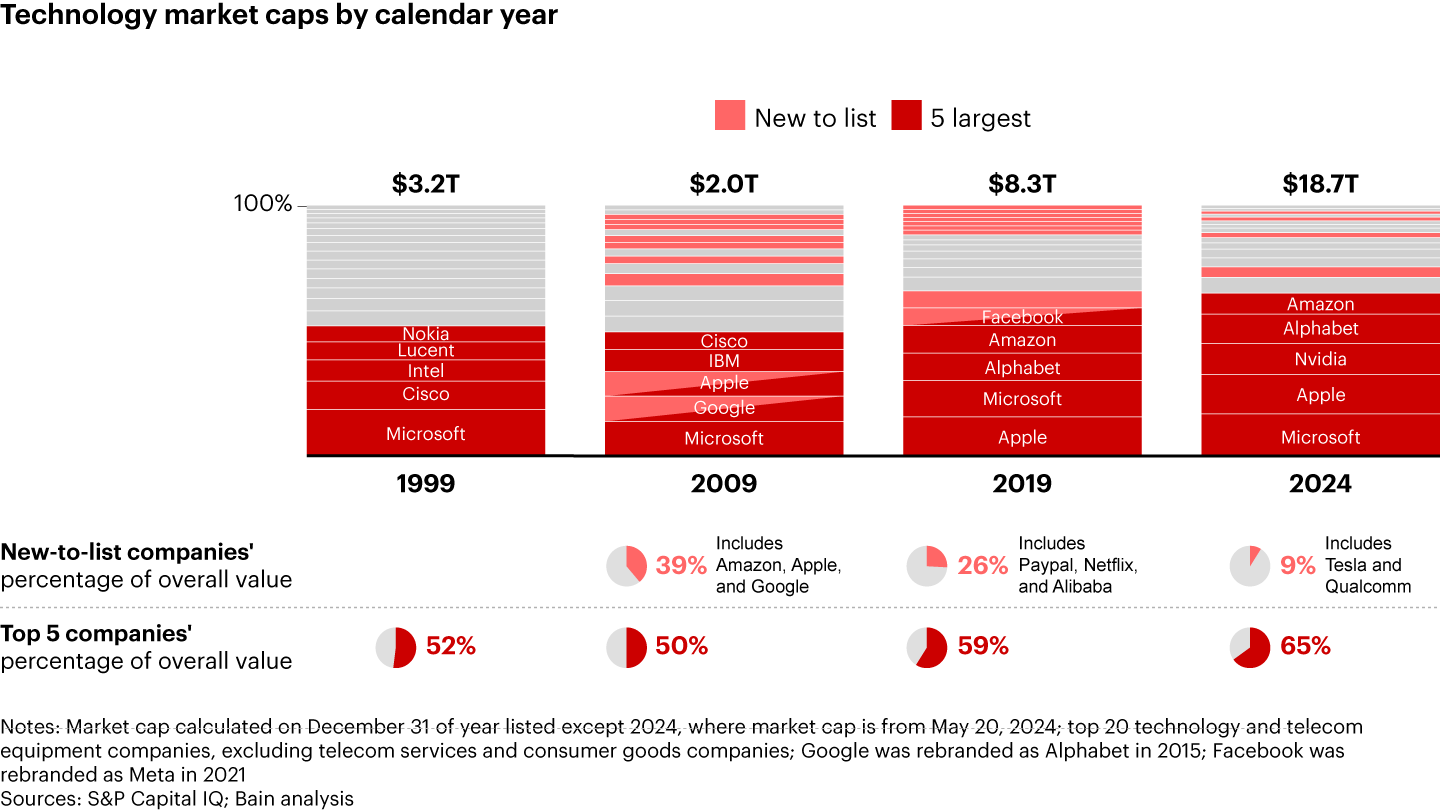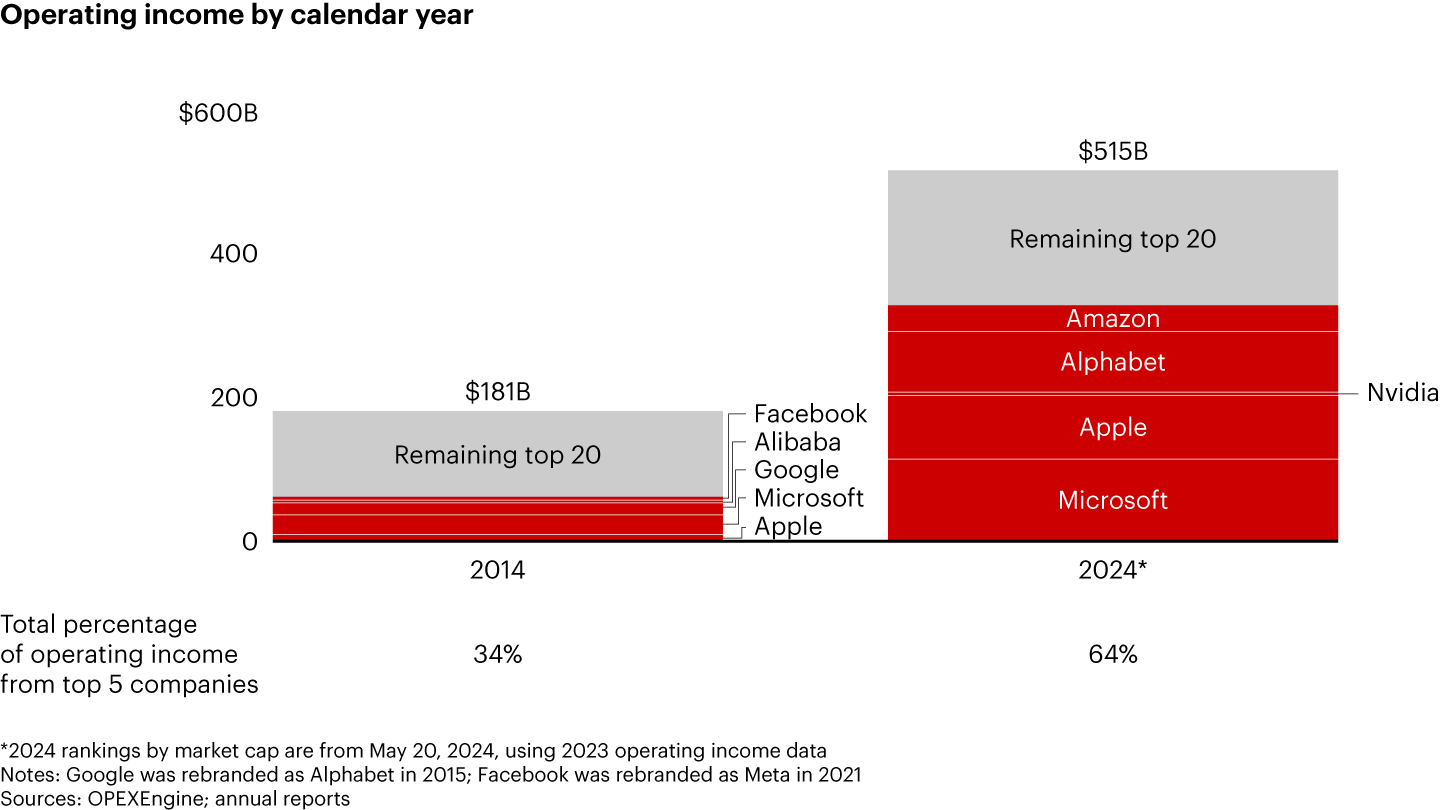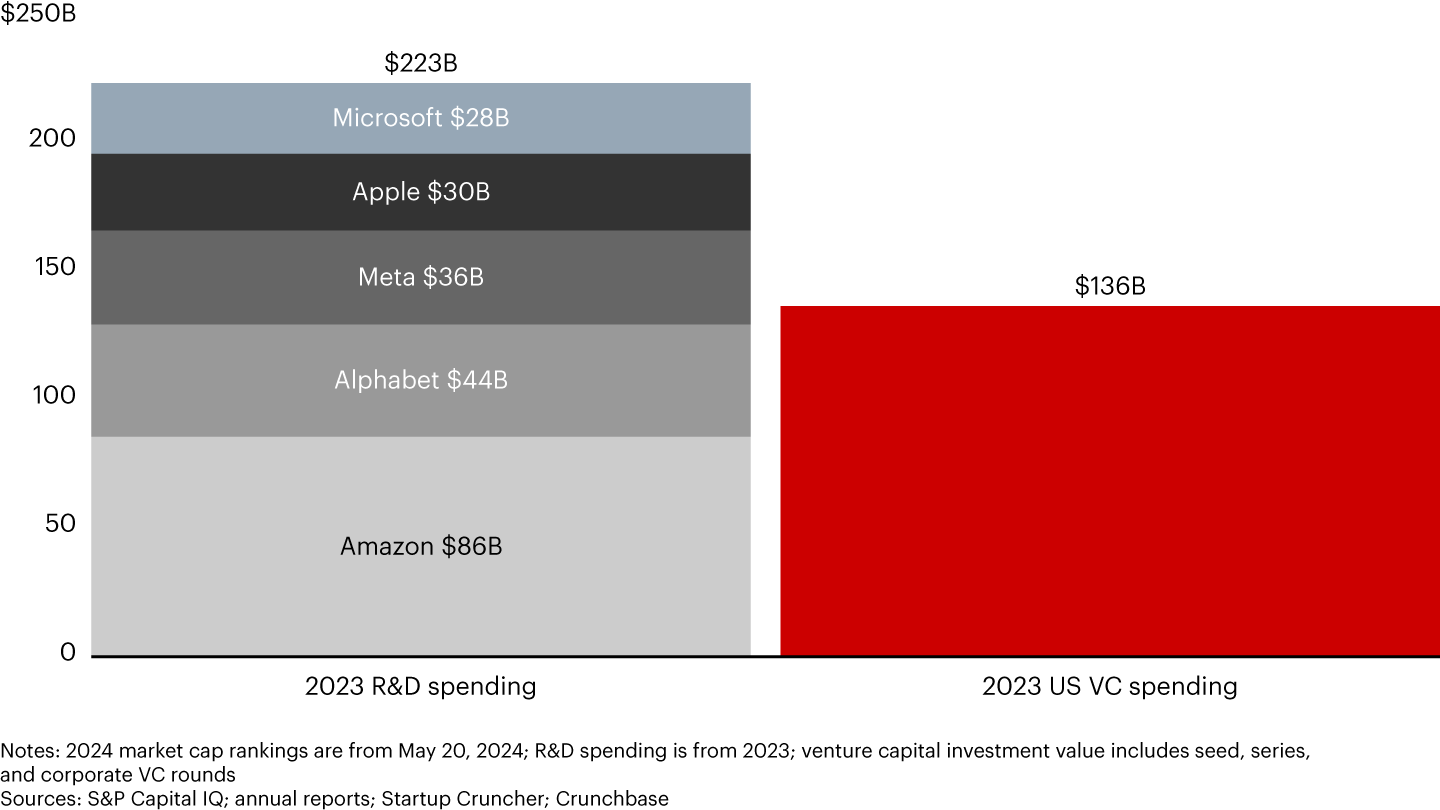Technology Report
 }
}
한눈에 보기
- Disruption rates are higher in technology than in other sectors. Typically, half of the 25 most valuable tech companies fall out of the top ranks every 10 years.
- Recently, the most valuable tech companies have shown remarkable resilience, holding spots at the top for many years and expanding their share of market value.
- Their success relies on their ability to identify disruptive trends and successfully scale and commercialize them, creating “winner takes most” dynamics.
- These companies may be seen as having a competitive advantage at a time when significant innovations require enormous resources in computational power, connectivity, and data.
This article is part of Bain's 2024 Technology Report.
Disruption in the technology sector hasn’t slowed down, but turnover among the top companies has: Four of the top five most valuable technology companies in 2024 were among the top tech companies in 2019, and three of the five were on the list in 2009—Microsoft, Apple, and Alphabet, which was then Google (see Figure 1).


What’s more, value is increasingly concentrated in these sector leaders. Together, the top five tech companies account for 63% of the market capitalization of the top 20 companies in the sector, up from only 53% a decade ago (see Figure 2). The top five also represent 64% of the profit pool, nearly twice the amount it was 10 years ago (34%).


This durability among tech leadership is atypical because disruption often shifts the leaderboard as new entrants rise at the expense of incumbents that traditionally have been more invested in existing technology and less able or willing to pivot and embrace disruptive technology.
What changed? One reason these leaders have thrived through disruption is they have built businesses with scale effects—on both the supply and demand side. On the supply side, commercializing technology innovations requires large volumes of computational power. This plays to the strengths of companies that have large computing assets and relevant competence. On the demand side, these businesses exhibit network effects that arise from mining huge data sets. The combination can create a “winner takes most” market dynamic and raise barriers to entry. These leaders also benefited from a period of intense globalization, which allowed them to enter new markets, increase their customer base, and accumulate scale. Additionally, in post-pandemic capital markets, investors have favored earnings and safety over rapid growth.
Ripe for disruption?
What can executives anticipate next? The waves of disruption roiling the tech industry today are so significant that they will test the durability of the incumbents and are likely to shift value in the sector.
- AI. The rapid and massive adoption of AI by companies across sectors will force change in the tech sector and beyond. Incumbent leaders including Alphabet and Microsoft are disrupting their own core businesses to focus on the AI opportunity. GPU leader Nvidia has burst into a top-tier position, achieving market cap values of more than $3 trillion in the second quarter of 2024.
- Geopolitics and national security. National and regional technology ecosystems are developing as countries look to reward allies and guard against competitive threats. Many national governments are subsidizing or otherwise incentivizing investment in local and national tech endeavors. A major security or geopolitical event could accelerate the pace of this disruption.
- Backlash against tech. The sector is under scrutiny by lawmakers and regulators in several regions who want to check the power of the largest tech companies. Acquisitions are under heavy scrutiny. Attempts to break apart large companies could generate new sources of disruption.
The combination of these and other pressures has the potential to shift the leaderboard, as shown by Nvidia’s rise to the top ranks over the past two years.
Takeaways for executives
The resilience of today’s leaderboard may be partly due to the benefits of scale. However, today’s technology leaders may also be skillful at identifying disruption and reinventing their businesses in ways that allow them to move from one strength to another. Running the core at full potential—ensuring that strategic, operational, financial, and organizational goals are met—is an essential foundation for achieving any growth ambitions. Sector leaders also demonstrate five important traits that have helped them stay at or rise to the top.
Be willing to self-disrupt. Incumbents must wrestle with the risk of cannibalizing existing businesses as they stand up new, competitive ones. Leaders find ways to fund new businesses, leveraging the momentum of existing ones. Today’s incumbents are better at self-disruption, finding ways to challenge their core business and keep their insurgent mission alive.
Ten years ago, Microsoft was struggling to maintain morale in the face of dire predictions about the fate of PCs and middling results of its big push into mobile phones. New CEO Satya Nadella helped reposition Microsoft as a leader in a cloud-first world, relaunching its Azure platform and recommitting to selling Office 365 as a service, even though cloud competed with its traditional server business. More recently, by partnering with OpenAI and integrating advanced AI into products like Azure and Office, Microsoft continues to champion innovation and challenge its core business.
More recently, Nvidia saw the opportunity to leverage technology used in its gaming GPUs to support parallel processing, essential for AI workloads and mining crypto currency. This forward thinking allowed it to embrace new trends, funding its new ventures with the profits from its gaming GPU business. The move diversified Nvidia’s revenue streams, solidified its role as a critical player in the future of technology, and in June 2024 made it the most valuable company in the world.
Identify new trends before they’re mainstream. These leaders develop sophisticated future-sensing capabilities. They develop alternate scenarios of possible futures and monitor market signals that indicate the direction of travel.
For example, Netflix recognized the inevitable rise of streaming video earlier than most competitors and transitioned from a DVD rental service to a streaming platform. Its timely shift positioned it as a market leader in digital content delivery and funded its large investments in original content creation.
Invest in innovation. Companies strengthen their long-term resilience by continually exploring and evaluating new growth engines. Tech leaders have become extremely profitable and are able to reinvest in innovation. In 2023, the big five hyperscalers (Microsoft, Apple, Alphabet, Meta, and Amazon) spent $223 billion on R&D, about 1.6 times as much as all venture capital spending in the US (see Figure 3). They have corporate venture capital capabilities and are investing in, working with, and sometimes acqui-hiring disruptive start-ups. Apple’s substantial investments in R&D have delivered significant competitive advantage over the years. One example is the Apple silicon project, which led to the development of the M1 and M2 chips that boosted performance and efficiency in its Mac line.


Make skillful use of M&A. Large M&A deals in the technology sector can expect significant regulatory scrutiny, but most large tech deals ultimately create more competition and lower prices for customers. Bain’s longitudinal analysis of M&A activity conducted by five large tech firms between 2005 and 2020 found that 72% of the deals increased competition and reduced prices (see Figure 4).
Large tech companies are able to attract top talent while also funding and commercializing innovation in a way that national labs, universities, and other research institutions struggle to accomplish. The cost of training a leading-edge generative AI model is an excellent example: It requires data, computational resources, and funding on a scale that few can achieve.
Build ecosystems and partnerships. Creating an ecosystem around disruptive innovations incentivizes other companies that can benefit financially from the incumbent’s platform. Ecosystems distribute R&D costs and increase the likelihood that partners may develop innovations that directly benefit the incumbent’s business. Amazon Web Services (AWS) has created a vast ecosystem that supports numerous start-ups and enterprises, fostering innovations that enhance its cloud services platform.
Even as the pace of technology continues to accelerate, the most valuable companies in technology are finding ways to embrace disruption and capture market value. At incumbents and new ventures alike, management teams should be looking ahead to identify the next innovation that could disrupt their core business or launch them into the top ranks of the sector.